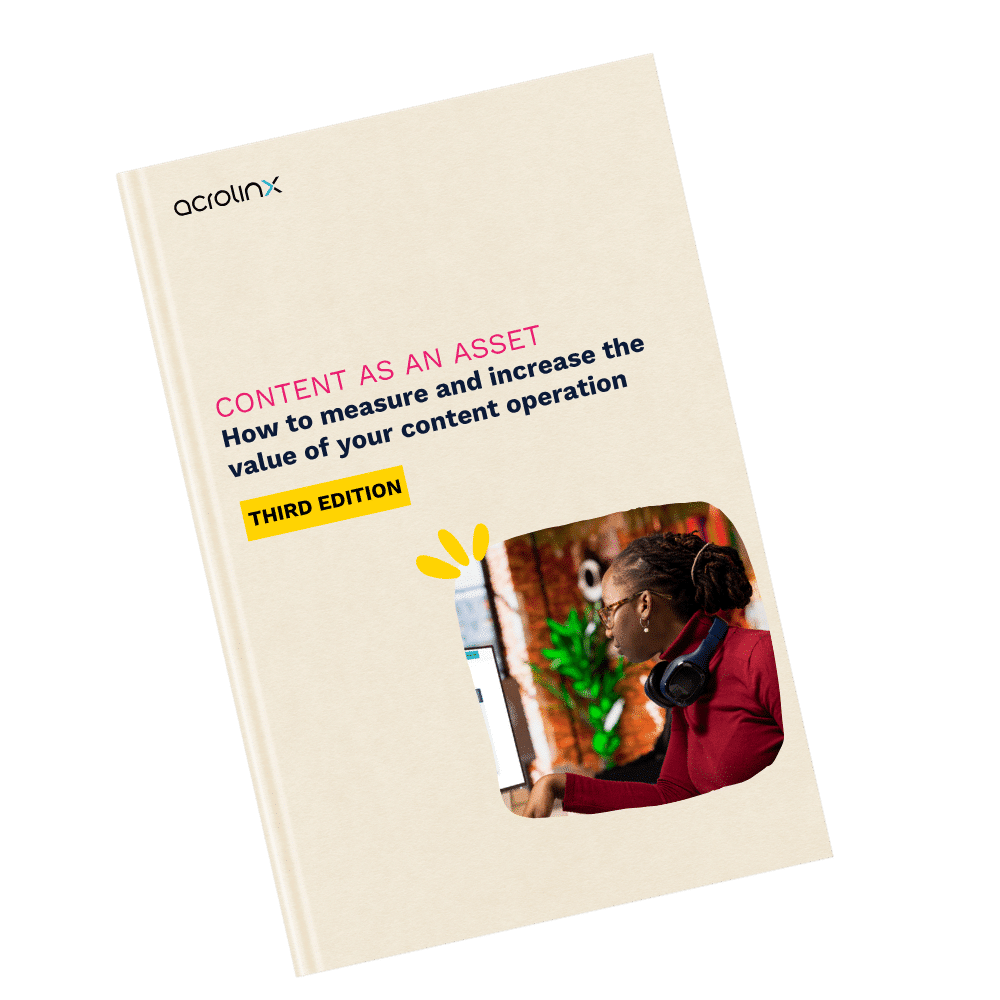How Much Does Content Creation Cost Your Business?

Content is one of your biggest business assets. Yet most businesses don’t bother calculating the cost of content. Whether that’s creating or maintaining it.
It’s time to change that if you want to start maximizing content’s value for your business.
Uncovering the cost of content
Content creation no longer belongs to the world of professional writers. These days everyone is creating content at work. And with the rise of generative AI, sometimes robots are creating your content too.
Regardless, your enterprise pays real people, real money to create content — often alongside their primary professional role. And the cost of creating that content is:
- Not on the company’s balance sheet
- Not a budget item
- Not actively managed or controlled
The consequences of not grasping the value of your content means you can’t improve its return on investment, and people put in effort where it creates the least amount of value. And that has a big impact on your revenue.
So, what goes into creating a single page of content? If you look at the time your team spends on content, more than a third is probably spent on manual efforts. Things like reviewing, editing, and battling inefficient ways of managing content across different creation tools. But that’s not where you cultivate the most value for your efforts.
Content creation costs time and money
A survey from Planable reports that “on average it takes 5.4 days from the creation to the actual publishing of a piece of content.” But that statistic doesn’t define how many words or pages a piece of content includes.
The report goes on to say that 5.4 days are fairly quick for most companies because 42% of teams have content lifecycles longer than 5 days. And that’s just for one piece, and one type of content. That 5.4 days turn out to be much, much, longer for companies that create multiple content types for a myriad of different products.
Ideally, you need to use technology and automation to reduce manual work and give talented individuals more time to spend on developmental and creative processes. Because it’s those areas of content creation that have the most value for your business. And it’s also what can increase the cost of content creation.
Understanding both the cost and time value of your content, and the annual spend to maintain and grow that content, gives content leaders the ability to maximize the value of content as a corporate asset.
It’s time to work smarter, not harder. Your employees need to focus their efforts on where they create the most value.
They need to spend less time focusing on the mechanical aspects of content creation and spend more time working on the creative aspects of content creation that result in quality content.
How to calculate your content creation cost
What’s the real cost of content creation? It’s time to calculate the total “hidden value” of your enterprise content asset. First you’ll need to answer these questions:
- How much content do we have?
- Where does it sit and how many systems do we have?
- How often do we update and maintain our content?
The best place to start is to estimate the cost of your existing content and the cost to maintain it. Then, you should predict the amount of new content you’ll need over the next 12 months. And calculate the costs to create and maintain it.
The next step is to focus on how much time your teams spend on content creation, to work out the possible efficiencies you could get by using technology to do manual tasks. Only through understanding the full scope of your content asset can you apply the right efficiencies to lower costs and increase value.
Collect, calculate, and measure
First, you need to take stock of the content you already have and work to maintain.
Content repository cost
Start with working out the number of content pages (like a web page, support page, blog post, or other types of content) you have and how much it costs to create each page. From here you can work the value of your enterprise content asset.
Tip: We advise that you break down your calculations by department and type of content. A premium asset like an eBook will cost more to create than a support article. Once you have the departmental value assessment, you can add these together to get your total enterprise content asset.
Maintenance cost
Now let’s work out the cost of maintaining and governing your content.
Figure out the number of pages you maintain and the cost of maintaining a page of content as a percentage of the cost to create a page. Let’s say you maintain 25,000 pages of content and it costs 15% of the initial $500 creation expense to maintain it. Your total cost would be $1,875,000.
New content creation cost
Then it’s time to consider how much your content creation will cost over the next 12 months.
First, work out how many pages you plan on creating each month and multiply that by the creation cost per page that you already worked out. Say you plan on creating 1,000 new pages each month. That means you’ll be spending six million dollars on new content for the upcoming year.
Of course, that’s not even taking into account the maintenance cost of the content created over the next 12 months. But you can replicate the maintenance calculation above if you want to factor that into future content creation costs.
Content is a massive asset for your enterprise
Once you spend the time to collect, calculate, and measure, it’s easy to see that content is one of your most valuable enterprise assets.
Now the focus shifts to how you can power efficiency across the content operation to get the most impact for every dollar you spend. Creating high-quality content — that meets its desired impact — increases the content’s lifecycle. Meaning it performs time and time again, and requires minimal maintenance.
Let’s explore how you can improve and build on your content operation — without spending more money.
Extend your content’s lifecycle
Everyone wants their content to retain value over time. But how do you achieve that?
One way is to prioritize creating evergreen content. Like developing core messaging or focusing on your audience’s pain points, which you can then reuse in different contexts. Implementing a content governance system is another sure way of extending your content’s lifecycle — and improving your content operations in general.
“Content governance is owning your content. Having the ability to edit, update, archive, publish, unpublish, and eventually change it for the times, all within a really structured set of guardrails.”
Megan Nixon, Senior Content Designer at Aetna (a CVS company)
Different parts of the content lifecycle are siloed across the business. And that’s reflected in inconsistencies in style, tone, terminology, and brand alignment at different points in the customer journey. Content governance maximizes the impact of your content across its lifespan by operationalizing your content strategy at scale.
It brings order to the chaos that exists in your company’s content operations, and helps everyone who creates and relies on that content to deliver better business outcomes. It doesn’t automatically mean that you’ll create long-lasting value through content, but it’s an essential step to getting there.
A note on content governance
Content governance is a systematic approach to capturing and digitizing your company’s content strategy. It also:
– Measures your current content status
– Guides content writers to achieve your stated goals
– Maintains content quality over time
– Improves overall performance
– Content governance revolutionizes your content operation.
Learn how to implement your own system in our playbook.
Maximize the value of your content asset today
For every enterprise, content represents an expected cost and value. But typically those things are hard to quantify. And producing content for content’s sake — without real insight into the impact it’s having (or not having) on your business — puts significant strain on your ability to create, maintain, and govern content that does its job (while also avoiding inefficiencies, waste, and budget overruns). And only through fully understanding the scope of your content asset can you apply the right efficiencies to lower costs and maximize value.
We’d like to help you better understand the value of your enterprise content, and show you how technology can make creating and maintaining it much more efficient.
Connect with us today to learn more or download our guide to calculate the value of your content.
Frequently asked questions
Costs vary based on volume, quality, and team structure. Acrolinx reduces long-term costs by minimizing rewrites, legal risks, and inefficiencies.
Enterprise content costs range widely, but inefficient processes can lead to overspending. Acrolinx helps improve content ROI.
By reducing the need for frequent rewrites. Acrolinx helps create content that’s evergreen, reusable, and compliant.
Governance platforms like Acrolinx reduce manual editing, speed up reviews, and prevent off-brand messaging that leads to rework.
Because of inconsistent quality and lack of reuse. Acrolinx streamlines updates by standardizing content and identifying what needs attention.
Are you ready to create more content faster?
Schedule a demo to see how content governance and AI guardrails will drastically improve content quality, compliance, and efficiency.

Charlotte Baxter-Read
Lead Marketing Manager at Acrolinx, bringing over three years of experience in content creation, strategic communications, and public relations. She holds a Master’s degree from the John F. Kennedy Institute, at Freie Universität Berlin, and a Bachelor's degree from Royal Holloway, University of London. Charlotte, along with the Acrolinx Marketing Team, won a Silver Stevie Award at the 18th Annual International Business Awards® for Marketing Department of the Year. She's a passionate reader, communicator, and avid traveler in her free time.





